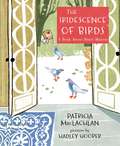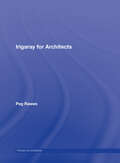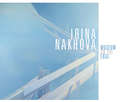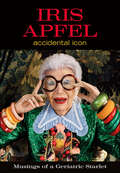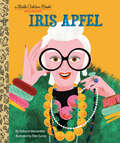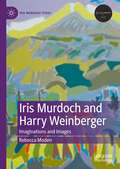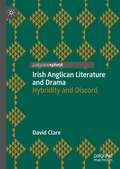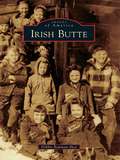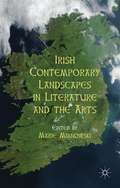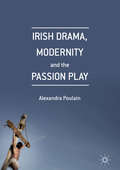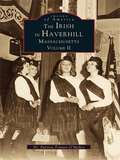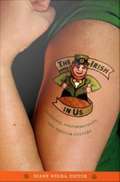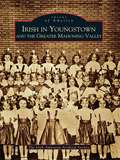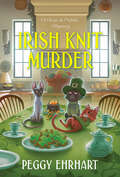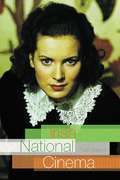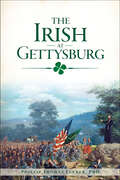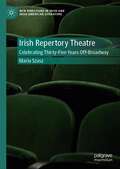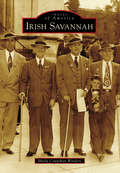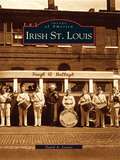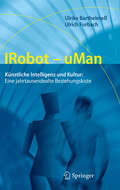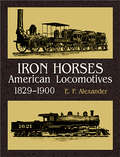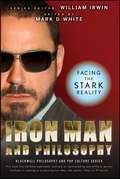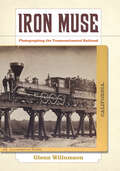- Table View
- List View
The Iridescence of Birds: A Book About Henri Matisse
by Patricia MacLachlanIf you were a boy named Henri Matisse who lived in a dreary town in northern France, what would your life be like? Would it be full of color and art? Full of lines and dancing figures? Find out in this beautiful, unusual picture book about one of the world's most famous and influential artists by acclaimed author and Newbery Medal-winning Patricia MacLachlan and innovative illustrator Hadley Hooper.
Irigaray for Architects (Thinkers for Architects)
by Peg RawesSpecifically for architects, the third title in the Thinkers for Architects series examines the relevance of Luce Irigaray’s work for architecture. Eight thematic chapters explore the bodily, spatio-temporal, political and cultural value of her ideas for making, discussing and experiencing architecture. In particular, each chapter makes accessible Irigaray’s ideas about feminine and masculine spaces with reference to her key texts. Irigaray’s theory of ‘sexed subjects’ is explained in order to show how sexuality informs the different ways in which men and women construct and inhabit architecture. In addition, her ideas about architectural forms of organization between people, exterior and interior spaces, touch and vision, philosophy and psychoanalysis are explored. The book also suggests ways in which these strategies can enable architectural designers and theorists to create ethical architectures for the user and his or her physical and psychological needs. Concisely written, this book introduces Irigaray’s work to practitioners, academics, undergraduate and postgraduate students in architectural design and architectural history and theory, helping them to understand the value of cross- and inter-disciplinary modes of architectural practice.
Irina Nakhova: Museum on the Edge
by Gabriella A. Ferrari Natalia SidlinaThroughout her extensive career, Russian conceptual artist Irina Nakhova has frequently pushed the limits of what constitutes art and how we experience the art museum. One of her famous early pieces, for instance, transformed a room in her very own Moscow apartment into an art installation. Released in conjunction with Nakhova’s first museum retrospective exhibition in the United States, this book includes many full-color illustrations of her work, spanning the entirety of her forty-year career and demonstrating her facility with a variety of media. It also includes essays by a variety of world-renowned curators and art historians, each cataloging Nakhova’s artistic innovations and exploring how she deals with themes of everyday life, memory, viewer engagement, and moral responsibility. It concludes with a new interview with Nakhova herself, giving new insight into her creative process and artistic goals. Irina Nakhova: Museum on the Edge provides a vivid look at the work of a visionary artist. Published in partnership with the Zimmerli Museum.
Iris Apfel: Accidental Icon
by Iris ApfelFrom the fashion icon, “a joyous, colorful collection of photographs; drawings; reflections; and personal mottos on marriage, business, fame and style” (Boca Raton Observer).The late great Iris Apfel was a woman who transcended time and trends—one of the most original and dynamic personalities in the worlds of fashion, textiles, and interior design. Written a few years before her passing at age 102, this is a lavishly illustrated memoir in which she shares her musings, anecdotes, and incomparable wisdom.As the cofounder with her husband of Old World Weavers, an international textile manufacturing company that specialized in reproducing antique fabrics, she served a prestigious clientele including Greta Garbo, Estee Lauder, Montgomery Clift, and Joan Rivers. She also acted as a restoration consultant and replicated fabric for the White House over nine presidential administrations. Iris’s worldwide travels and devotion to flea markets inspired her work and fueled her passion for collecting fashion and accessories. In 2005, she was the first living person who was not a designer to have her clothing and accessories exhibited at the Costume Institute at the Metropolitan Museum of Art, a blockbuster show that catapulted her to fame and a career as a model, muse, and collaborator for renowned brands from Citroen to Tag Heuer. In 2015, acclaimed director Albert Maysles released Iris, his Emmy Award-nominated documentary, to a global audience.This celebratory volume captures her unique joie de vivre and features 180 full-color and black-and-white photos and illustrations—presented in the same improvisational, multifaceted style that made Iris a much-loved legend. “It’s hard to resist this self-proclaimed ‘geriatric starlet.’ With her owlish glasses, loud prints and necklaces upon necklaces, even in her 90s, Apfel is a fashion icon who combines a memoir with photos of the vibrant contents of her closets.” —The New York Times Book Review
Iris Apfel: A Little Golden Book Biography (Little Golden Book)
by Deborah BlumenthalHelp your little one dream big with a Little Golden Book biography about Iris Apfel, the style icon and beloved tastemaker known for her eclectic eyewear! Little Golden Book biographies are the perfect introduction to nonfiction for preschoolers.This Little Golden Book about Iris Apfel—businessperson, interior designer, and fashion icon who has captivated the world with her colorful and unique style—is an inspiring read-aloud for young children.Look for more Little Golden Book biographies: • Misty Copeland • Frida Kahlo • Bob Ross • Queen Elizabeth II • Harriet Tubman
Iris Murdoch and Harry Weinberger: Imaginations and Images (Iris Murdoch Today)
by Rebecca ModenThe novelist and philosopher Iris Murdoch and the painter Harry Weinberger engaged in over twenty years of close friendship and intellectual discourse, centred on sustained discussion of the practice, teaching and morality of art. This book presents a reappraisal of Murdoch’s novels – chiefly, three mature novels, The Sea, The Sea (1978), Nuns and Soldiers (1980) and The Good Apprentice (1985), and two enigmatic late novels, The Green Knight (1993) and Jackson’s Dilemma (1995) – which are perceived through the prism of her discourse with Weinberger. It draws on a run of almost 400 letters from Murdoch to Weinberger, and on Murdoch’s philosophical writings, Weinberger’s private writings, the remarks of both artists in interviews, and other material relating to their views on art and art history, much of which is unpublished and has received no previous critical attention. Scrutiny of their shared values, methods and the imagistic dialogue that takes place in their art provides original perspectives on Murdoch’s creativity, and new ways of understanding her experimentation with the visual arts. This book offers a new line of enquiry into Murdoch's novels, and into the relationship between literature and the visual arts.
Irish Anglican Literature and Drama: Hybridity and Discord
by David ClareThis book discusses key works by important writers from Church of Ireland backgrounds (from Farquhar and Swift to Beckett and Bardwell), in order to demonstrate that writers from this Irish subculture have a unique socio-political viewpoint which is imperfectly understood. The Anglican Ascendancy was historically referred to as a “middle nation” between Ireland and Britain, and this book is an examination of the various ways in which Irish Anglican writers have signalled their Irish/British hybridity. “British” elements in their work are pointed out, but so are manifestations of their proud Irishness and what Elizabeth Bowen called her community’s “subtle … anti-Englishness.” Crucially, this book discusses several writers often excluded from the “truly” Irish canon, including (among others) Laurence Sterne, Elizabeth Griffith, and C.S. Lewis.
Irish Butte (Images of America)
by Debbie Bowman SheaSummoned by the call of the copper mines in Butte, Montana, Irish immigrants left a struggling Ireland at the beginning of the 20th century in search of a better life. Around the mines peppering the hills of the mining city, these determined sons and daughters of Eire built strong Irish neighborhoods that engendered the best of Irish culture and influence. Faith, family, a strong work ethic, and a sense of humor would see these immigrants through the decades. Celebrations like St. Patrick's Day and An Ri Ra, Irish language workshops, and a new generation of Irish artisans acknowledge the contributions of this influential group.
Irish Contemporary Landscapes in Literature and the Arts
by Marie MianowskiLooking at representations of the Irish landscape in contemporary literature and the arts, this volume discusses the economic, political and environmental issues associated with it, questioning the myths behind Ireland's landscape, from the first Greek descriptions to present day post Celtic-Tiger architecture.
Irish Drama, Modernity and the Passion Play
by Alexandra PoulainThis book discusses Irish Passion plays (plays that rewrite or parody the story of the Passion of Christ) in modern Irish drama from the Irish Literary Revival to the present day. It offers innovative readings of such canonical plays as J. M. Synge’s The Playboy of the Western World, W. B. Yeats’s Calvary, Brendan Behan’s The Hostage, Samuel Beckett’s Endgame, Brian Friel’s Faith Healer and Tom Murphy’s Bailegangaire, as well as of less well-known plays by Padraic Pearse, Lady Gregory, G. B. Shaw, Seán O’Casey, Denis Johnston, Samuel Beckett and David Lloyd. Challenging revisionist readings of the rhetoric of “blood sacrifice” and martyrdom in the Irish Republican tradition, it argues that the Passion play is a powerful political genre which centres on the staged death of the (usually male) protagonist, and makes visible the usually invisible violence perpetrated both by colonial power and by the postcolonial state in the name of modernity.
Irish Housing Design 1950 – 1980: Out of the Ordinary (Ashgate Studies in Architecture)
by Brian Ward Michael Pike Gary BoydThis book examines the architectural design of housing projects in Ireland from the mid-twentieth century. This period represented a high point in the construction of the Welfare State project where the idea that architecture could and should shape and define community and social life was not yet considered problematic. Exploring a period when Ireland embraced the free market and the end of economic protectionism, the book is a series of case studies supported by critical narratives. Little known but of high quality, the schemes presented in this volume are by architects whose designs helped determine future architectural thinking in Ireland and elsewhere. Aimed at academics, students and researchers, the book is accompanied by new drawings and over 100 full colour images, with the example studies demonstrating rich architectural responses to a shifting landscape.
Irish in Haverhill, Massachusetts, The: Volume II (Images of America)
by Dr Patricia O'MalleyIrish immigration to Haverhill, Massachusetts, was a constant from the days of the Great Famine to the present. The immigrants, their children, and their grandchildren have become an integral part of the fabric of the city's history. Some were teachers, politicians, police officers, and business owners, while others spent their lives as city laborers and factory workers. Whether these new residents were wealthy or poor, well known or little known, their experiences in America could not eliminate their common ties to the Emerald Isle. They collectively share a place in this "family album" of those Irishcitizens who called Haverhill their new home. This volume is the sequel to the The Irish in Haverhill,Massachusetts, which was published in 1998. The response to that book was so enthusiastic that the author was overwhelmed with offers of additional photographs for a second volume.
The Irish in Us: Irishness, Performativity, and Popular Culture
by Diane NegraOver the past decade or so, Irishness has emerged as an idealized ethnicity, one with which large numbers of people around the world, and particularly in the United States, choose to identify. Seeking to explain the widespread appeal of all things Irish, the contributors to this collection show that for Americans, Irishness is rapidly becoming the white ethnicity of choice, a means of claiming an ethnic identity while maintaining the benefits of whiteness. At the same time, the essayists challenge essentialized representations of Irishness, bringing attention to the complexities of Irish history and culture that are glossed over in Irish-themed weddings and shamrock tattoos. Examining how Irishness is performed and commodified in the contemporary transnational environment, the contributors explore topics including Van Morrison's music, Frank McCourt's writing, the explosion of Irish-themed merchandising, the practices of heritage seekers, the movie The Crying Game, and the significance of red hair. Whether considering the implications of Garth Brooks's claim of Irishness and his enormous popularity in Ireland, representations of Irish masculinity in the TV series Buffy the Vampire Slayer and Angel, or Americans' recourse to a consoling Irishness amid the racial and nationalist tensions triggered by the events of September 11, the contributors delve into complex questions of ethnicity, consumerism, and globalization. Ultimately, they call for an increased awareness of the exclusionary effects of claims of Irishness and for the cultivation of flexible, inclusive ways of affiliating with Ireland and the Irish. Contributors. Natasha Casey, Maeve Connolly, Catherine M. Eagan, Sean Griffin, Michael Malouf, Mary McGlynn, Gerardine Meaney, Diane Negra, Lauren Onkey, Maria Pramaggiore, Stephanie Rains, Amanda Third
Irish in Youngstown and the Greater Mahoning Valley (Images of America)
by The Irish American Archival SocietyIn 1796, Daniel Shehy of Tipperary was the first Irish man to settle in Youngstown. In the early nineteenth century, the Ulster Irish moved into the region. Later, massive waves of Irish refugees from the Potato Famine settled in the area and filled the labor needs of the steel mills, canals, and railroads. Irish in Youngstown and the Greater Mahoning Valley recounts the history of the first Irish immigrants to settle the Valley up to the present and their prominent roles in community politics, arts, business, sports, entertainment, and religion. Through vintage images of families, church leaders, business owners, politicians, Irish dancers, and philanthropists, this book celebrates the influence of the Irish on the Greater Mahoning Valley.
Irish Knit Murder (A Knit & Nibble Mystery #9)
by Peggy EhrhartA member of a prominent New Jersey family has been found dead on St. Patrick&’s Day—and Pamela Paterson and her knitting club have a parade of suspects . . . The Listers have been part of Arborville society for generations—though seventy-something Isobel Lister doesn&’t fit the role of upper-crust heiress. She&’s always been a colorful character, and her fun-loving spirit is on display at the senior center celebration as she performs some beloved Irish songs. But just minutes later, her body is found backstage. It&’s hard to imagine who&’d target such a harmless eccentric, but Pamela finds herself suspecting everyone. There&’s the Wiccan who thought St. Patrick wasn&’t so saintly; the woman upset about cultural appropriation who feels the commercialization of shamrocks is a sham; the two men Isobel was seeing, who could have been green with jealousy—and old friends and family who may have feared Isobel would spill their secrets. But Pamela&’s on the case, and that means for the killer, the jig will soon be up . . . Praise for Peggy Ehrhart and the Knit & Nibble Mysteries!&“This is one of the best in the series.&” —Kirkus Reviews on Death of a Knit Wit Knitting tips and delicious recipe included!
Irish National Cinema (National Cinemas)
by Ruth BartonFrom the international successes of Neil Jordan and Jim Sheridan, to the smaller productions of the new generation of Irish filmmakers, this book explores questions of nationalism, gender identities, the representation of the Troubles and of Irish history as well as cinema's response to the so-called Celtic Tiger and its aftermath. Irish National Cinema argues that in order to understand the unique position of filmmaking in Ireland and the inheritance on which contemporary filmmakers draw, definitions of the Irish culture and identity must take into account the so-called Irish diaspora and engage with its cinema. An invaluable resource for students of world cinema.
The Irish of Gettysburg (Civil War Ser.)
by Philip Thomas TuckerAt the outbreak of the Civil War, Irish citizens on both sides of the Mason-Dixon answered the call to arms. This was most evident at the Battle of Gettysburg.Louisiana Irish Rebels charged with the cry "We are the Louisiana Tigers!" Irish soldiers of the Alabama Brigade and the Texas Brigade launched assaults on the line's southern end at Little Round Top. During Pickett's Charge, Gaelic brothers fought each other as determined Irishmen of the Sixty-Ninth Pennsylvania Volunteer Infantry repelled Irish of the Virginia Brigade in one of the most decisive moments in American history. Author Phillip Thomas Tucker reveals the compelling story.
The Irish Repertory Theatre: Celebrating Thirty-Five Years Off-Broadway (New Directions in Irish and Irish American Literature)
by Maria SzaszThe Irish Repertory Theatre: Celebrating Thirty-Five Years Off-Broadway is the first book-length history of the multi-award winning Off-Broadway Irish Repertory Theatre Company, from its beginning in 1988 to its thirty-fifth season in 2023. The book considers how the Irish Rep’s plays and musicals reflect the Irish diaspora, the relationship between Ireland and America, and what it means to be Irish and Irish American, both historically, and in the twenty-first century, including how the Irish Rep is showcasing more diverse voices and experiences, from women, the LGBTQIA+ community, and Irish and Irish American people of color.
Irish Savannah (Images of America)
by Sheila Counihan WindersMost people have heard the words to this song: "Tis Irish I am and 'tis proud I am of it." But, what does it mean to be Irish? When the Irish first came to Savannah, it meant they were either "lace curtain" or "old fort." Lace curtain inferred that the family was prosperous, usually Protestant, and had come to Savannah with letters of introduction, money, and a plan. Old fort meant that the family had come to America in desperation and to Savannah with little but the clothes on their back, the desire to work, and hope for a better future. Old fort Irish were generally Catholic, attending Catholic schools and depending on the Church for far more than just Sunday worship. Today, the Irish have spread all over Savannah like shamrocks, making these designations a thing of the past. The Irish are involved in every facet of Savannah life, from politics, to business, to education. Catholicism remains the predominant religion and churches abound, as do Catholic schools. When the "Season of St. Patrick" begins, the Savannah Irish begin celebrating.
Irish St. Louis (Images of America)
by David A. LossosIt's quite unlikely that Pierre Laclede and Auguste Chouteau could have comprehended the scope of their undertaking in 1764 when they laid out the settlement on the western banks of the Mississippi that was to become the metropolis of St. Louis. Founded by the French, governed by the Spanish, and heavily populated by the English and Germans, the role that the Irish had in making St. Louis what it is today is often overlooked. The Irish are steeped in tradition, and that trait did not leave the Irish immigrants when they arrived in St. Louis and called this place home. Like many other cities in America, the heritage of Ireland is alive and well in St. Louis. This book visually captures their Irish spirit, and portrays a few of the Irish "movers and shakers" alongside the "Irish commoner" in their new and challenging lives here in St. Louis.
Irish Theatre in Transition
by Donald E. MorseThe Irish Theatre in Transition explores the ever-changing Irish Theatre from its inception to its vibrant modern-day reality. This book shows some of the myriad forms of transition and how Irish theatre reflects the changing conditions of a changing society and nation.
IRobot - uMan
by Ulrich Furbach Ulrike BarthelmeßWarum werden Roboter oft als bedrohlich empfunden? Können künstliche Systeme Emotionen und Bewusstsein haben? Die Autoren gehen von der These aus, dass die Literatur- und Geistesgeschichte uns helfen kann, aktuelle Entwicklungen der Robotik unvoreingenommen zu betrachten. Denn ob es um mittelalterliche Mythen, androide Roboter der Romantik, die Aufklärung oder die Entwicklung der künstlichen Intelligenz geht, stets stellt sich die Frage nach dem, was der Mensch ist, was sein Bewusstsein ausmacht und was ihn von anderen Wesen unterscheidet.
Iron Horses: American Locomotives 1829-1900 (Dover Transportation)
by E. P. AlexanderColorful stories of the old steam engines of yesteryear fill these pages -- from the steam carriage operated on the streets of Paris in 1769 to the mighty locomotives that thundered across the American West in the latter half of the 19th century. 98 plates of fine, rare illustrations, many rendered by the author.
Iron Man and Philosophy: Facing the Stark Reality
by Mark D. WhiteThe first look at the philosophy behind the Iron Man comics and movies, timed for the release of Iron Man 2 in March 2010. On the surface, Iron Man appears to be a straightforward superhero, another rich guy fighting crime with fancy gadgets. But beneath the shiny armor and flashy technology lies Tony Stark, brilliant inventor and eccentric playboy, struggling to balance his desires, addictions, and relationships with his duties as the Armored Avenger. Iron Man and Philosophy explores the many philosophical issues that emerge from the essential conflicts found in the decades of Iron Man stories in comics and movies. What kind of moral compass does Tony Stark have? Is Iron Man responsible for the death of Captain America after the Marvel Universe "Civil War"? Should people like Stark run the world? How does Tony's alcoholism impact his performance as Iron Man, and what does it say about moral character? Ultimately, what can Iron Man teach us about the role of technology in society? As absorbing as Iron Man comic books and movies, Iron Man and Philosophy: Gives you a new perspective on Iron Man characters, story lines, and themes Shows what philosophical heavy hitters such as Aristotle, Locke, and Heidegger can teach us about Tony Stark/Iron Man Considers issues such as addiction, personal responsibility, the use of technology, and the role of government Whether you've been reading the comic books for years or have gotten into Iron Man through the movies, Iron Man and Philosophy is a must-have companion for every fan.
Iron Muse: Photographing the Transcontinental Railroad
by Glenn WillumsonThe construction of the transcontinental railroad (1865–1869) marked a milestone in United States history, symbolizing both the joining of the country’s two coasts and the taming of its frontier wilderness by modern technology. But it was through the power of images—and especially the photograph—that the railroad attained its iconic status. Iron Muse provides a unique look at the production, distribution, and publication of images of the transcontinental railroad: from their use as an official record by the railroad corporations, to their reproduction in the illustrated press and travel guides, and finally to their adaptation to direct sales and albums in the late nineteenth and twentieth centuries. Tracing the complex relationships and occasional conflicts between photographer, publisher, and curator as they crafted the photographs’ different meanings over time, Willumson provides a comprehensive portrayal of the creation and evolution of an important slice of American visual culture.
